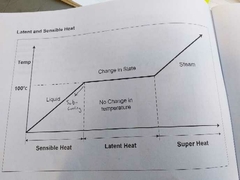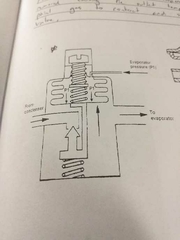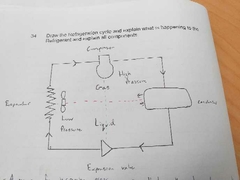![]()
![]()
![]()
Use LEFT and RIGHT arrow keys to navigate between flashcards;
Use UP and DOWN arrow keys to flip the card;
H to show hint;
A reads text to speech;
37 Cards in this Set
- Front
- Back
- 3rd side (hint)
|
Definition of refrigeration |
The science of producing and maintaining a temperature below that of the surrounding area |
|
|
|
State the reasons why refrigeration machinery is used in the RNZN |
Preserve food supplies Provide air conditioning Provide chilled water cooling to electronic cabinets Making ice for domestic use and medical purposes |
PPPM |
|
|
What are the advantages of freezing foods? |
Frozen foods are readily prepared, saving time and labor Easier portion control and labor Compact storage Foods are always in season Additional stocks in hand Guaranteed quality |
FECFAG |
|
|
3 types of heat transfer, give an example of each |
Conduction- heat transmission by contact. Eg through a steel bar
Convection- the natural movement of heat within a liquid or gas
Radiation- the transfur of heat by electro magnetic waves |
|
|
|
Maximum fill of a recovery cylinder? |
80% |
|
|
|
What are the laws of refrigeration |
1. A liquid can be made to evaporate, or boil, either by adding heat or reducing the pressure on the surface, or a combination of both 2. A vapour can be made to liquefy, or condense, by increasing the pressure acting upon it, by extracting heat, or by a combination of both. 3. Heat travels only from an area of high concentration to one of low concentration (heat will flow from warm to less warm) 4. An evaporating liquid that is cooler than its surroundings will accept from its surroundings, yet remains at the lower temperature until evaporation. |
|
|
|
Draw and label heat graph diagram |

|
|
|
|
What is an oil separator and how does it work? |
The separator is made of a welded steel cylinder with a fine wire mesh internal arrangement. The gas changes direction passing through the mesh throughing tiny oil particles out by using centrifugal force. The pil drops to the bottom and accumulates until it lifts the float valve removing the oil back to the compressor. |
|
|
|
Name the safety devices fitted to the refrigeration plant |
High pressure cut out Low pressure cut out Combined low and high pressure cut out |
|
|
|
Where will you find the safety procedures for refrigeration |
NZBR 2020 NZBR 7 |
|
|
|
Are there any other references in other BRs for refrigeration |
Yes |
|
|
|
As for sentry posted outside the refrigeration compartment what would initial response be to a casualty? |
Raise the alarm gas gas gas Give the location of the incident to HQ1 Don BA and enter compartment place eeda on all casualties. Under no circumstances enter compartment without BA Assits duty watch/standing sea emergency party with casualtie evacuation |
|
|
|
As a result of the ozone layer protection act 1990 the RNZN has converted most refrigeration machinery to what refrigerant, and why? |
Most machinery is run on R134A or R404A as they have zero ozone depleting properties and are environmentally friendly not like the older R12 and R22 |
|
|
|
Why are safety devices fitted to refrigeration systems? |
To minimize danger to personal, damage to machinery, and loss of expensive refrigerants. |
|
|
|
What is the effect on the boiling point of a liquid if: Lower pressure acting on its surface?
Increase the pressure acting on its surface? |
Boiling point is reduced and less heat it needed
Will increase the boiling point, more heat is required to make it boil |
|
|
|
Complete the following sentence Refrigerant 134a & 404a have__________hence is more__________ |
Zero ozone depleting propertie potential Friendly to the environment |
|
|
|
If there was any moister in the refrigerant what problems would it cause? |
Would cause water to freeze in the oriface of the expansion valve, thus blocking the valve and stopping the flow of refrigerant to the evaporator. |
|
|
|
What are the potential health effects of refrigerants and explain them? |
Eyes- liquid refrigerant in the eyes may cause blindness by freezing the moisture in the eyes. Skin contact- liquid refrigerant coming in contact with the skin may cause serious frostbite Suffocation- refrigerants are heavier than air and will readily replace the air in a space or lungs Electrical shock- extreme care should be taken while working on any electrical component |
|
|
|
Name the main and subtypes or refrigerant compressor used in the RNZN |
Reciprocating compressor Open type compressor Semi-hermetic compressor Domestic hermetic compressor Screw compressor |
DR SOS |
|
|
Draw and describe how the thermostatic expansion valve works |

Evaporator outlet pipe has a sensing Phil which reacts to temperature change. If the evaporator outlet temp is high the gas in Phial heats up and expands. This increases pressure in the valve which pushes down the push pin opening the valve, allowing more refrigeration to flow into the evaporator and allowing more heat to be removed. Valve closes when temperature drops and Phial gas contracts. |
|
|
|
Explain the common refrigeration terms Latent heat Charge Dew point Cycle Hermetically sealed unit Sensible heat Sub cooling Superheated Absolute pressure Change of state |
Latent heat- heat added or removed which cannot be measured by a change in temperature but accomplished by a change in state Charge- amount of refrigerant in a system Dew point- the temperature at which moisture in the air will condense if cooled at constant pressure Cycle- complete course of operation of refrigerant back to the start point. Hermetically sealed unit- a sealed unit in which the compressor and compressor motor are enclosed in the same housing with no external shaft or shaft seal, and the compressor motor operates in the refrigerant atmosphere. Sensible heat- heat added or removed which can be measured by a change in temperature of the fluid or substance. Sub cooling- process of cooling liquid refrigerant below condensing temperature, for a given pressure. Superheat- is the additional heat absorbed by the gas, thereby increasing its temperature without further changing its state. Absolute pressure- absolute pressure is measured from absolute zero rather than atmosphere pressure. It equals gauge pressure minus 14.7 psi or 100 kPa Change of state- change from on phase, such as solid, liquid or gas kPa Change of state- change from on phase, such as solid, liquid or gas |
|
|
|
What are the arrangements for ventilation of refrigeration compartments |
All compartments containing refrigerant machinery should be ventilated with a natural supply of air and the exhaust kept running at all times when machinery is running or being maintained |
|
|
|
What safety precautions should be under taken in regards to the ventilation before entering a refrigeration compartment? |
Before entering any compartment contening refrigerant machinery, the ventilation to and from the compartment is to be inspected to ensure that the ventilation fans are running and the flow of air is unrestricted. |
|
|
|
What is the best treatment for overexposure to refrigerants |
Get the victim to air |
|
|
|
Can you smell refrigerant |
No |
|
|
|
Overexposure of refrigerations can cause High concentrations can cause Very high concentrations can cause |
High concentrations cause feelings of light headedness and dizziness
Very high concentrations cause unconsciousness and death and an irregular heartbeat, which can be fatel |
|
|
|
The ozone layer protection act 1990 stipulates what? |
That it is illegal in New Zealand go knowingly or without lawful justification or excuse, release a controlled substance into the atmosphere while installing, operating servicing, modifying or dismantling any refrigeration or AC equipment or other heat transfer medium. |
|
|
|
What is the NZDF policy when working on refrigeration type equipment? |
states that equipment susceptible to leakage of uncontrolled substances is to be carried out strictly IAW existing and improved servicing instructions |
|
|
|
What is the fail mode of the thermostatically opened solenoid valve? |
It will move to a safe position if their is an electrical fault or power failure |
|
|
|
How is the compressor protected from liquid passover |
To prevent damage the liquid acts against the discharge valve causing the whole valve and valve body to lift against the spring tension allowing the liquid to escape |
|
|
|
When would a DRIER be replaced |
When a new change of oil has been put into the system When oil analyst results indicate water content in an excess of 0.01% When the refrigerant or lube oil systems have been open to the atmosphere |
|
|
|
Why do we have back seated valves |
To enable system isolation for changing and maintenance |
|
|
|
What is the normal operating position of a back seated valve |
Back seated, fully to the rear, fully open |
|
|
|
Draw the refrigeration cycle and explain and explain what is happening to the refrigerant and explain all components |

Compressor- a means of increasing the pressure so that the temperature ay which the vapor will condense if above cooling seawater Condenser- gas gives up its latent health of condensation to the sea water and changes to liquid Expansion valve- a means of reducing pressure so that the boiling point of the liquid is lower than required temperature of the coldest room Evaporator- the liquid absorbs its heat of evaporation from the cooled food room and changes to gas |
|
|
|
Why do we use a back pressure regulating valve on some systems |
To maintain a different room temperature in a refrigerating system where more than one room is fed off the same compressor |
|
|
|
What does the back pressure regulating valve do for our system |
The lowest temperature that a room can come down too is directly related to the suction pressure in the evaporator. So by limiting the suction pressure we limit how cold the room can get |
|
|

Label the back pressure regulating valve in the picture below |

|
|

